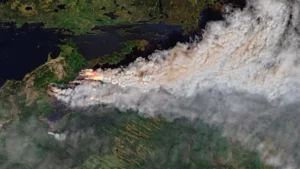Introductin:

In the face of escalating climate change, coastal cities are grappling with the heightened frequency and intensity of major hurricanes. Addressing this imminent threat, researchers at MIT have developed an innovative method to predict and comprehend the intricate dynamics of compound flooding resulting from hurricanes in a warming climate. The approach not only considers traditional factors like storm surges and heavy rainfall but delves into the intricate interplay between these elements, providing a more comprehensive understanding of the risks posed to coastal communities.
To achieve this, MIT scientists have employed a physics-based risk assessment methodology, breaking away from the limitations of relying solely on historical records. By simulating hurricane activity with virtual “seeds” scattered into a simulated climate, researchers can observe how these storms evolve under various ocean and atmospheric conditions. This forward-looking approach allows for a more accurate prediction of future hurricane risks, considering the changing structural characteristics, frequency, intensity, and movement of hurricanes in response to climate change.
The Impact of Hurricanes on Coastal Regions
As hurricanes make landfall, the complex nature of their impact becomes evident, with multiple sources of flooding contributing to the devastation. Storm surges, fueled by strong winds, combine with torrential rainfall, creating compound flooding that can have far-reaching consequences, as witnessed in the aftermath of Hurricane Sandy in 2012. The MIT researchers emphasize the importance of their physics-based method in unraveling the intricacies of compound flooding, enabling a more precise assessment of risks in coastal cities.
By focusing on the specific case of New York City, the team sheds light on how climate change may influence the risk of compound flooding from hurricanes similar to Sandy in the coming decades. The projections reveal a concerning trend, with the frequency of Sandy-like compound flooding events expected to increase significantly, posing a fivefold greater risk to the city by the end of the century. These insights are crucial for city planners and policymakers to develop adaptive measures and enhance the resilience of infrastructure and communities against the evolving risks posed by hurricanes in a warming climate.
A Closer Look at New York City
Applying their innovative compound flood-modeling method, the MIT team embarked on an in-depth analysis with a particular focus on New York City, aiming to unravel the intricate interplay of climate change on the risk of compound flooding stemming from hurricanes comparable to the destructive Hurricane Sandy in the coming decades. By leveraging their advanced methodology, the researchers sought to move beyond traditional assessments that often rely on historical records, recognizing the limitations posed by the dynamic nature of climate change. Instead, they simulated hurricane activity with virtual “seeds” scattered into a carefully designed simulated climate, allowing them to observe and understand how storms evolve under various ocean and atmospheric conditions.
In this unique approach, the MIT researchers delved into the structural characteristics, frequency, intensity, and movement of hurricanes, acknowledging that climate change significantly alters these parameters. Focusing on New York City as a test case, the team aimed to provide granular insights into the evolving risks faced by coastal cities. The projections unveiled a concerning trend, indicating that, in today’s climate, a Sandy-level compound flooding event is expected approximately every 150 years. However, as we progress towards midcentury, the frequency is projected to surge to every 60 years, and by the end of the century, the city may face such catastrophic events every 30 years—a fivefold increase compared to the present climate. These findings underscore the urgency for adaptive measures and strategic planning to fortify the city’s resilience against the escalating risks posed by hurricanes in a warming climate.
Projections for New York City
In today’s climate, the study reveals that a Sandy-level compound flooding event is expected to occur in New York City approximately every 150 years. However, as we approach midcentury, the frequency is projected to increase to every 60 years. By the end of the century, these destructive floods may occur every 30 years, marking a fivefold increase compared to the present climate.
5: Planning for the Future
Despite the sobering projections, the researchers emphasize the importance of these flood forecasts in helping city planners prepare and protect against future disasters. The methodology provides essential tools for conducting detailed, granular-level compound flooding risk assessments, extending to each street or building, both in current and future decades.
6: A Methodology Beyond Historical Records
Traditional flood risk assessments rely on historical records, but the limitations of these records become evident when considering the dynamic nature of climate change. The MIT team takes a different approach, using a physics-based risk assessment methodology that considers changing climate conditions and the structural characteristics of hurricanes.
Seeding Future Floods
To predict future flood risks, the researchers simulate hurricane activity by scattering thousands of virtual “seeds” of hurricanes into a simulated climate. These seeds grow into storms based on ocean and atmospheric conditions, allowing scientists to understand how hurricanes may change in terms of intensity, frequency, and size under various climate scenarios.

The Role of Sea Level Rise
The team also accounts for the impact of sea level rise in their models, recognizing it as a significant factor in amplifying the risk of compound flooding. As sea levels rise in coastal areas, the potential for devastating flooding from hurricanes increases, particularly in densely populated regions such as New York City.
9: Urgency and Future Populations
The urgency of this research is underscored by the projected 25 percent increase in coastal populations by midcentury. With trillions of dollars in assets at risk in flood-prone areas, proactive strategies are essential to reduce damages from compound flooding caused by hurricanes in a warming climate.
Applying the Methodology Worldwide
The study’s methodology is not limited to New York City and can be applied to any coastal city to assess the risk of compound flooding from hurricanes and extratropical storms. By doing so, decision-makers can make informed choices about implementing adaptive measures to enhance infrastructure and community resilience.
Financial Support and Acknowledgments
This groundbreaking research was supported, in part, by Homesite Insurance. The collaborative effort involved experts from MIT’s Lorenz Center, Columbia University, the University of Bristol, the Charles III University of Madrid, and the Swiss Federal Institute of Technology Lausanne. Their collective contributions have provided valuable insights into the evolving risks of compound flooding in a warming climate.
Conclusion
In conclusion, the MIT-led study provides a sobering glimpse into the future challenges faced by coastal cities in the wake of climate change. The increasing frequency of compound flooding events poses a substantial threat to the safety and stability of these communities. While the projections are alarming, the researchers stress the importance of their flood forecasts in empowering city planners to prepare and protect against future disasters. The methodology, extending to each street or building, provides an essential tool for decision-makers to conduct detailed compound flooding risk assessments, ensuring a proactive approach to mitigating the impact of hurricanes in a warming climate. As we grapple with the urgency of protecting coastal populations and trillions of dollars in assets situated in flood-prone areas, the study underscores the need for immediate and effective strategies to reduce damages from compound flooding under a changing climate.
